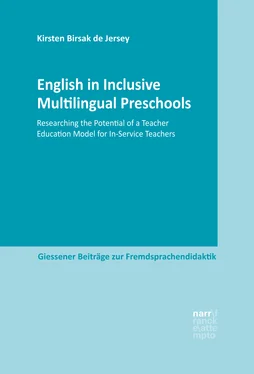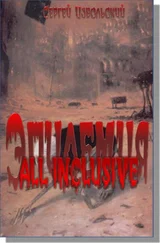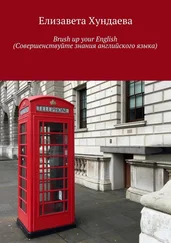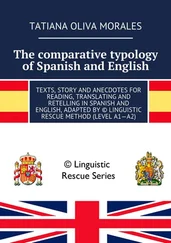Kirsten Birsak de Jersey - English in Inclusive Multilingual Preschools
Здесь есть возможность читать онлайн «Kirsten Birsak de Jersey - English in Inclusive Multilingual Preschools» — ознакомительный отрывок электронной книги совершенно бесплатно, а после прочтения отрывка купить полную версию. В некоторых случаях можно слушать аудио, скачать через торрент в формате fb2 и присутствует краткое содержание. Жанр: unrecognised, на английском языке. Описание произведения, (предисловие) а так же отзывы посетителей доступны на портале библиотеки ЛибКат.
- Название:English in Inclusive Multilingual Preschools
- Автор:
- Жанр:
- Год:неизвестен
- ISBN:нет данных
- Рейтинг книги:3 / 5. Голосов: 1
-
Избранное:Добавить в избранное
- Отзывы:
-
Ваша оценка:
- 60
- 1
- 2
- 3
- 4
- 5
English in Inclusive Multilingual Preschools: краткое содержание, описание и аннотация
Предлагаем к чтению аннотацию, описание, краткое содержание или предисловие (зависит от того, что написал сам автор книги «English in Inclusive Multilingual Preschools»). Если вы не нашли необходимую информацию о книге — напишите в комментариях, мы постараемся отыскать её.
English in Inclusive Multilingual Preschools — читать онлайн ознакомительный отрывок
Ниже представлен текст книги, разбитый по страницам. Система сохранения места последней прочитанной страницы, позволяет с удобством читать онлайн бесплатно книгу «English in Inclusive Multilingual Preschools», без необходимости каждый раз заново искать на чём Вы остановились. Поставьте закладку, и сможете в любой момент перейти на страницу, на которой закончили чтение.
Интервал:
Закладка:
Non-native speakers of English in particular, as a study comparing advantages and disadvantages of native to non-native speakers of English has demonstrated, are likely to use the language of instruction more often if their communicative English language competence is of a low level in comparison to those who speak more fluently. The level of English proficiency not only influences the amount of English spoken during the lesson, but it also influences the actual teaching process. Teachers with a low level of communicative competence were found to be “inclined to adopt a more controlled and cautious pedagogical approach” (Medgyes, 2001, p. 435).
At the same time, as has already been said, Cameron maintains rightly that the language of instruction should not be excluded completely (Cameron, 2001, p. 200). This is also true for multilingual contexts. Although the context here is one in which many children at the beginning of their preschool life cannot speak German and learn to become proficient at different rates, the language of instruction remains the language of communication. As a result, after a year many of the children can understand basic German or more, and other children can also speak it. The teachers are well on the way to being able to communicate with the children for another two years while the children develop their German language competences more and more. There are also children whose mother tongue is German. Therefore, preschool teachers habitually use the language of instruction in their classroom routines, regardless of who understands them and who does not. It becomes the common language that is used between the preschool teachers and the children. Cameron clarifies her suggestion that the language of instruction should not be excluded by saying that if there is a common language that the children and the teachers share it would be very unnatural not to use it (p. 200). The relevance of this suggestion has been confirmed by my observations: children often keep using the language of instruction while the teacher continues talking in the target language. Nonetheless, it is of course appropriate to encourage the children to speak English and to establish the routine of speaking more and more English in class. But it would be inappropriate to force them. Emotional situations, confusions, critical incidents and some questions may require the common language of instruction so that issues can be appropriately solved. Similarly, it can be used to quickly abate any interruptions or disturbances to the flow of the lesson. But not only as seen from the needs of children but also from the perspective of some researchers the use of the language of instruction in English teaching may have its place. Butzkamm (2008) is a case in point. He put forward the idea of distinguishing between message- and medium-orientated- communication (→ chapter 5.7.4) to optimize the target language contact time and states that instead of pretending that a common language does not exist, the teachers should selectively use it (p. 327; translated by Birsak de Jersey). Through conscious use message- and medium orientated- communication in the classroom it is possible to give children a high quantity of repeated exposure of the target language:
Kindliche Lernende brauchen Wiederholungen. Nur wenn die gelernten Strukturen ständig wiederholt werden, bleiben die Lerninhalte nachhaltig im Gedächtnis verankert. Sie können dann auch nach längerer Pause mit geringem Aufwand wieder abgerufen werden. Die erwachsenen Personen, die den Bildungsprozess begleiten, sollten die Zielsprachen dabei konsequent verwenden. Nur so können die Kinder lernen, dem Gesagten Sinn zu entnehmen. Durch Wiederholungen und Abwandlungen wird das Erlebte gefestigt. Dann kann es auch in anderen Situationen angewandt werden” (Stern, 1994, p. 19; as cited in Boeckmann).
To conclude, it can be assumed at this point, that a confident, flexible communicative English language competence is an important precondition that accounts for the quality of teaching while at the same time teachers need to learn when it is appropriate to resort to the commonly shared language of instruction if it is available. As all of the preschool teachers that have taken part in my case study are non-native speakers of English (→ chapter 3.2), there is a gap between the communicative English language competence that is required and what teachers are actually able to do. The participating teachers do not feel confident to speak English continually and spontaneously. Therefore, a focus on developing preschool teachers’ classroom discourse competences will be integrated in my teacher education project. I will look at the possibility of developing participating teachers’ speaking skills from the level they are at in a way that assists them to create a task language classroom (→ chapters 5.7.4 and 5.8).
4.3.2 Pedagogical content knowledge
Apart from a sound communicative English language competence , prospective English teachers need to be able to “make it [the target language] comprehensible to others” (Shulman, 1986, p. 9). This knowledge came to be termed pedagogical content knowledge in 1986 for the first time by Shulman. He defined it as “content knowledge that embodies the aspects of content most germane to its teachability … [that is] the ways of representing and formulating the subject that makes it comprehensible to others” (p. 9).
Through pedagogical content knowledge, teachers develop “the capability to transform content into accessible learning forms” (Burns & Richards, 2009, p. 3). It consists of both theory and practice and the inter-relationship of these two components and ultimately culminates in knowledge of how to teach and how to facilitate learning.
The question of what this knowledge base consists of has been explicitly addressed by research conducted in connection with finding out how teachers develop professionally. This required addressing the question of what qualifies as the knowledge base of second language teacher education to begin with (Freeman & Johnson, 1998, p. 407; Johnson, 2009, p. 21). Freeman and Johnson were among the first to react against the idea that until then prevailed the discussion that disciplinary knowledge1 and theories of second language acquisition (SLA) alone would prepare teachers adequately for language classrooms (Freeman & Johnson, 1998). Instead, they argued, the knowledge base of teacher education would need to be reconceptualised to include pedagogical content knowledge (Johnson, 2009, pp. 21-22). This knowledge base cannot be defined without a particular group of learners in mind. What can be defined, though, is the general approach and principles for teaching languages (→ chapter 5.8). The pedagogical content knowledge appropriate for a particular group of learners may only be developed by ‘translating’ these principles in the design of tasks that then have to be tested in practice and reflected on their appropriateness for this particular group of learners. This way teachers will gain an insight into problems that can occur, they will develop a perception of how to put theory to practice and will become aware of how they respond in and to their context (Schön, 1983, pp. 54-55; Johnson, 2009, p. 23). Reflecting practical experiences and drawing conclusions to improve the quality of learning for a particular group of learners form the basis for teachers’ decision making in classrooms. Therefore, what qualifies as appropriate content for a particular group of learners can only be defined through this process of reflection in context. This research therefore consequently sets up a teacher education model which supports participating teachers to develop the pedagogical content knowledge for their preschool groups.
Читать дальшеИнтервал:
Закладка:
Похожие книги на «English in Inclusive Multilingual Preschools»
Представляем Вашему вниманию похожие книги на «English in Inclusive Multilingual Preschools» списком для выбора. Мы отобрали схожую по названию и смыслу литературу в надежде предоставить читателям больше вариантов отыскать новые, интересные, ещё непрочитанные произведения.
Обсуждение, отзывы о книге «English in Inclusive Multilingual Preschools» и просто собственные мнения читателей. Оставьте ваши комментарии, напишите, что Вы думаете о произведении, его смысле или главных героях. Укажите что конкретно понравилось, а что нет, и почему Вы так считаете.











